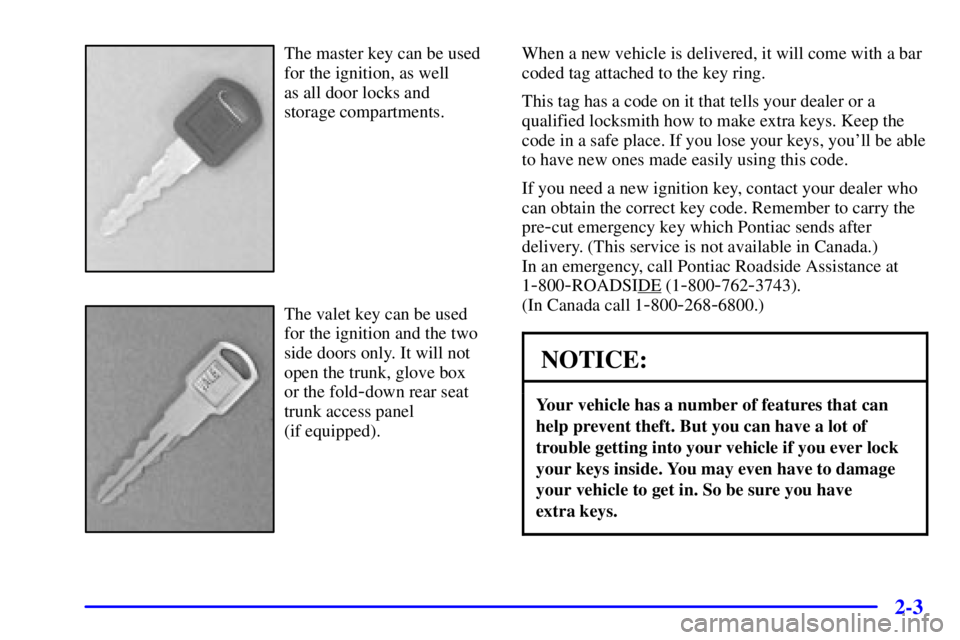Page 71 of 376

2-3
The master key can be used
for the ignition, as well
as all door locks and
storage compartments.
The valet key can be used
for the ignition and the two
side doors only. It will not
open the trunk, glove box
or the fold
-down rear seat
trunk access panel
(if equipped).When a new vehicle is delivered, it will come with a bar
coded tag attached to the key ring.
This tag has a code on it that tells your dealer or a
qualified locksmith how to make extra keys. Keep the
code in a safe place. If you lose your keys, you'll be able
to have new ones made easily using this code.
If you need a new ignition key, contact your dealer who
can obtain the correct key code. Remember to carry the
pre
-cut emergency key which Pontiac sends after
delivery. (This service is not available in Canada.)
In an emergency, call Pontiac Roadside Assistance at
1
-800-ROADSIDE (1-800-762-3743).
(In Canada call 1
-800-268-6800.)
NOTICE:
Your vehicle has a number of features that can
help prevent theft. But you can have a lot of
trouble getting into your vehicle if you ever lock
your keys inside. You may even have to damage
your vehicle to get in. So be sure you have
extra keys.
Page 91 of 376

2-23
Trunk
CAUTION:
It can be dangerous to drive with the trunk open
because carbon monoxide (CO) gas can come into
your vehicle. You can't see or smell CO. It can
cause unconsciousness and even death.
If you must drive with the trunk open or if
electrical wiring or other cable connections must
pass through the seal between the body and
the trunk:
�Make sure all other windows are shut.
�Turn the fan on your heating or cooling
system to its highest speed with the setting
on VENT. That will force outside air into
your vehicle. See ªComfort Controlsº in
the Index.
�If you have air outlets on or under the
instrument panel, open them all the way.
See ªEngine Exhaustº in the Index.
Trunk Lock
To unlock the trunk from the outside, insert the master
key and turn the key clockwise. You can also press the
trunk symbol on the remote keyless entry transmitter
(if equipped).
Remote Trunk Release (If Equipped)
Press the button located
behind the glove box door
to unlock the trunk from
inside the vehicle.
The shift lever must be in PARK (P) for the remote
trunk release button to work.
Page 92 of 376

2-24
Theft
Vehicle theft is big business, especially in some cities.
Although your vehicle has a number of theft
-deterrent
features, we know that nothing we put on it can make it
impossible to steal. However, there are ways you
can help.
Key in the Ignition
If you leave your vehicle with the keys inside, it's an
easy target for joy riders or professional thieves
-- so
don't do it.
When you park your vehicle and open the driver's door,
you'll hear a chime reminding you to remove your key
from the ignition and take it with you. Always do this.
Your steering wheel will be locked, and so will your
ignition and transaxle. And remember to lock the doors.
Parking at Night
Park in a lighted spot, close all windows and lock your
vehicle. Remember to keep your valuables out of sight.
Put them in a storage area, or take them with you.
Parking Lots
If you park in a lot where someone will be watching
your vehicle, it's best to lock it up and take your keys.
But what if you have to leave your ignition key?
�If possible, park in a busy, well lit area.
�Put your valuables in a storage area, like your trunk
or glove box. Be sure to close and lock the
storage area.
�Close all windows.
�Lock the glove box.
�Lock all doors except the driver's.
�Give the valet key to the valet. Then take the master
key with you.
Page 127 of 376
2-59 Convex Outside Mirror
Your passenger's side mirror is convex. A convex
mirror's surface is curved so you can see more from the
driver's seat.
CAUTION:
A convex mirror can make things (like other
vehicles) look farther away than they really are.
If you cut too sharply into the right lane, you
could hit a vehicle on your right. Check your
inside mirror or glance over your shoulder before
changing lanes.
Storage Compartments
Glove Box
Use the master key to lock and unlock the glove box.
To open, lift the right side of the latch.
Overhead Console (Option)
The optional overhead console has reading lamps and
storage compartments (including one for your garage
door opener and one for sunglasses). These features are
explained on the following pages.
Page 132 of 376

2-64
NOTICE:
Adding some electrical equipment to your vehicle
can damage it or keep other things from working
as they should. This wouldn't be covered by your
warranty. Check with your dealer before adding
electrical equipment, and never use anything that
exceeds the fuse rating.
Auxiliary Power Connection
(Power Drop)
The vehicle is equipped with auxiliary power
connections. This feature can be used to power
aftermarket electrical equipment added to the vehicle.
The connections are located on the passenger's side of
the vehicle, below the glove box.
OnStar� System (If Equipped)
OnStar is a vehicle communications service. The
following services are available through a subscription
with OnStar and are available 24 hours a day:
Emergency Services
�Automatic Notification of Air Bag Deployment
�Theft Notification and Stolen
-Vehicle Tracking
�Roadside Assistance with Location
�Remote Diagnostics
�OnStar MED
-NET
�Accident Assist
Convenience Services
�Remote Door Unlock
�Route Support
�Concierge Services
�Ride Assist
A complete user's guide is provided with the OnStar
System. For more information contact OnStar
at 1
-888-ONSTAR7.
Page 135 of 376
2-67
The main components of the instrument panel are:
A. Side Window Defogger Vents
B. Fog Lamp Switch
C. Multifunction Lever
D. Instrument Panel Cluster
E. Hazard Button
F. Full Floating Horn
G. Trip Computer/Driver Information Center (DIC)
H. Instrument Panel Vents
I. Interior Lamp ControlJ. Exterior Lamp Control
K. Tilt Wheel Control
L. Audio Steering Controls (If Equipped)
M. HUD Display Controls (If Equipped)
N. Comfort Controls
O. Ashtray and Cigarette Lighter
P. Audio System
Q. Glove Box
R. Instrument Panel Fuse Block
Page 330 of 376
6-63 Instrument Panel Fuse Block
Some fuses are in a fuse block located inside of the
glove box behind a small bin on the right side. To open,
pull the cover out. The fuse block is inside. On the back
edge of this cover is a fuse puller and a fuse usage chart.
To use the fuse puller, place the wide end of the fuse
puller over the plastic end of the fuse. Squeeze the ends
over the fuse and pull it out.
To reinstall the bin, position the lower end and turn the
top into position. Press on the sides until it snaps
into place.Circuit Description
Breaker
HEADLAMP Headlamps
SEAT Power Seat, Power Lumbar
BLANK Blank
PWR WDO Power Windows
BLANK Blank
Page 353 of 376

7-16 At Least Twice a Year
Restraint System Check
Make sure the safety belt reminder light and all your
belts, buckles, latch plates, retractors and anchorages are
working properly. Look for any other loose or damaged
safety belt system parts. If you see anything that might
keep a safety belt system from doing its job, have it
repaired. Have any torn or frayed safety belts replaced.
Also look for any opened or broken air bag coverings,
and have them repaired or replaced. (The air bag system
does not need regular maintenance.)
Wiper Blade Check
Inspect wiper blades for wear or cracking. Replace blade
inserts that appear worn or damaged or that streak or
miss areas of the windshield. Also see ªWiper Blades,
Cleaningº in the Index.
Weatherstrip Lubrication
Silicone grease on weatherstrips will make them last
longer, seal better, and not stick or squeak. Apply
silicone grease with a clean cloth. During very cold,
damp weather more frequent application may be
required. (See ªRecommended Fluids and Lubricantsº
in the Index.)Automatic Transaxle Check
Check the transaxle fluid level; add if needed. See
ªAutomatic Transaxle Fluidº in the Index. A fluid loss
may indicate a problem. Check the system and repair
if needed.
At Least Once a Year
Key Lock Cylinders Service
Lubricate the key lock cylinders with the lubricant
specified in Part D.
Body Lubrication Service
Lubricate all hood hinges, hood latch assembly,
secondary latch, pivots, spring anchor, release pawl,
door hinges, rear compartment, glove box door, console
door and any folding seat hardware. Part D tells you
what to use. More frequent lubrication may be required
when exposed to a corrosive environment.